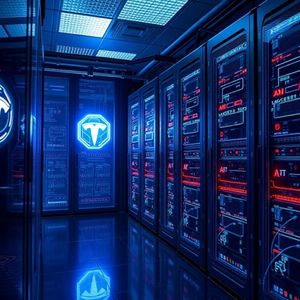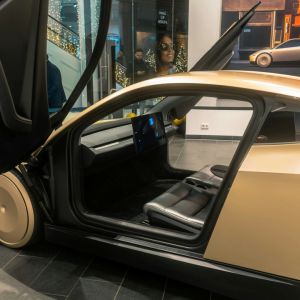Tesla Dojo: Elon Musk Confirms Shutdown, Unveiling a Bold New AI Strategy
4 min read
BitcoinWorld Tesla Dojo: Elon Musk Confirms Shutdown, Unveiling a Bold New AI Strategy The tech world is abuzz with Elon Musk’s latest revelation: Tesla’s ambitious Tesla Dojo AI supercomputer project, once hailed as a cornerstone for full self-driving, has been confirmed as an ‘evolutionary dead end.’ This surprising pivot marks a significant shift in Tesla’s approach to artificial intelligence, impacting everything from autonomous vehicles to humanoid robots. The Unexpected End: Why Tesla Dojo Was Deemed an ‘Evolutionary Dead End’ For years, Tesla Dojo was a highly anticipated initiative, envisioned by Elon Musk as the powerhouse for training AI models crucial for autonomous driving and humanoid robotics. The project involved a mix of Nvidia GPUs and Tesla’s in-house D1 chips, with plans for a second iteration, ‘Dojo 2,’ powered by next-generation D2 chips. However, over the weekend, Musk confirmed via his social media platform X that the team behind Dojo had been disbanded. His explanation was clear: “Once it became clear that all paths converged to AI6, I had to shut down Dojo and make some tough personnel choices, as Dojo 2 was now an evolutionary dead end.” This decisive move signals a complete re-evaluation of Tesla’s AI hardware development path. Elon Musk’s AI Vision: Consolidating Resources for a Singular Focus The decision to halt Dojo development is rooted in Elon Musk’s AI philosophy of efficiency and resource optimization. He articulated that it no longer made sense for Tesla to divide its resources across two distinct AI chip designs. Instead, the company is now channeling all its efforts into a unified architecture. Musk stated, “The Tesla AI5, AI6 and subsequent chips will be excellent for inference and at least pretty good for training. All effort is focused on that.” This strategic consolidation aims to streamline development and maximize impact, rather than spreading engineering talent thin across disparate projects. He even hinted at a ‘Dojo 3’ concept, which would involve integrating many AI5/AI6 chips onto a single board, drastically reducing network complexity and cost for supercomputer clusters. Powering the Future: The Strategic Shift to AI Chips (AI5 & AI6) With Tesla Dojo in the rearview mirror, the spotlight now shines brightly on Tesla’s AI5 and AI6 chips. These new generation AI chips are being manufactured by industry giants TSMC and Samsung, respectively, signaling a reliance on established chip fabrication expertise. AI5 Chip: Primarily designed to power FSD (Full Self-Driving), Tesla’s advanced driver assistance system. This chip is crucial for processing real-time data and making instantaneous decisions on the road. AI6 Chip: A more versatile powerhouse, engineered for both onboard inference – meaning it will drive self-driving capabilities in cars and autonomous functions in humanoid robots – and large-scale AI training. Its dual functionality makes it a central component of Tesla’s future AI endeavors. This pivot emphasizes a unified chip design capable of handling both the training and inference needs of Tesla’s ambitious AI projects. Beyond the Road: What This Means for Full Self-Driving and Robotics The implications of this strategic shift extend far beyond just hardware. For Tesla’s long-promised Full Self-Driving capabilities, the transition to AI5 and AI6 chips means a refined, more focused development path. While the initial robotaxi launch in Austin saw reported incidents of problematic driving behavior, the company’s commitment to achieving true autonomy remains firm, now underpinned by this consolidated chip strategy. Furthermore, the AI6 chip’s design for onboard inference in humanoid robots like Optimus underscores Tesla’s broader ambitions in robotics. This move suggests a stronger, more integrated approach to developing intelligent systems that can operate effectively in the real world, whether on roads or in factories. Navigating the Future: Unpacking Tesla’s AI Strategy Amidst Challenges This strategic pivot comes at a critical juncture for Tesla. The company has faced challenges with falling EV sales and brand damage following Musk’s political forays. By doubling down on a unified Tesla AI strategy , Musk aims to reassure investors that the company’s future lies squarely in its advanced autonomy and AI capabilities. The fate of the Dojo facility in Buffalo, New York, where Tesla had invested $500 million, remains unclear. Bitcoin World has reached out to Tesla for more information on this and the status of ‘Cortex,’ another ‘giant new AI training supercluster’ Musk had touted around August 2024. As Tesla navigates these complexities, its renewed focus on a streamlined AI chip architecture is a bold bet on its autonomous future. To learn more about the latest AI market trends, explore our article on key developments shaping AI models features. This post Tesla Dojo: Elon Musk Confirms Shutdown, Unveiling a Bold New AI Strategy first appeared on BitcoinWorld and is written by Editorial Team

Source: Bitcoin World



